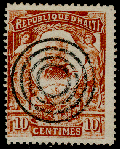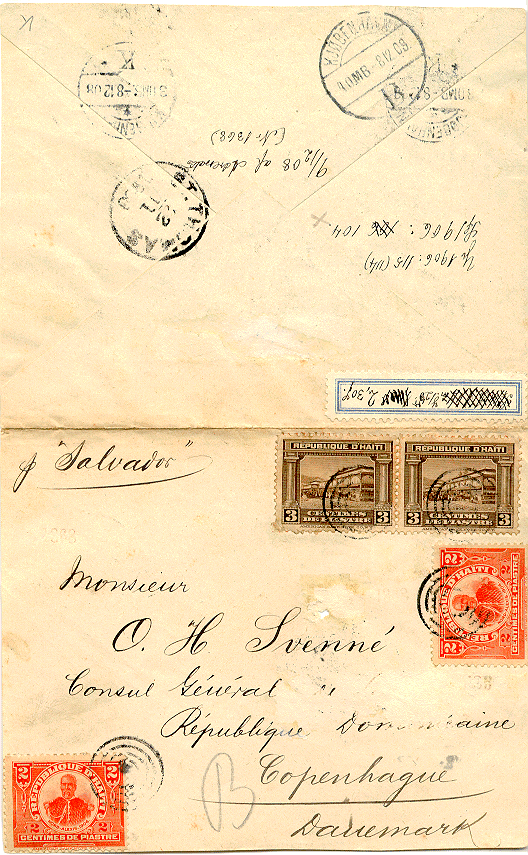Henrik Mouritsen's pages
Postal history of Haiti - The mute cancel of St.Thomas

Henrik Mouritsen's pagesPostal history of Haiti - The mute cancel of St.Thomas |

|
The Kingdom of Denmark made its political and economic presence felt in the Caribbean with the take-over of the island of St. Thomas in the year 1666. In the years immediately following, it also acquired through force the neighboring islands of St.John and St. Croix. The strategic importance of the three islands did not go appreciated by the giant to the island's north, for the United States (i.e., Union) during the Civil tried to purchase the islands. However, the United States Senate refused to vote the $7,000,000 needed for their acquisition. In 1917, the United States, however, did purchase St. Thomas and St. John for the then tidy sum of $25,000,000. Ostensibly the Danish government was only too willing to sell at the time, fearing that either the United States or Germany --soon-to-be ennemies in World War I-- would confiscate the islands without any compensation. It should be noted that Germany prohably exercised greater influence and power than the United States on the island of St. Thomas, at least, for at Charlotte Amalie the German-owned Hamburg-American Line (HAPAG) had wharves, docks, etc. Too, vessels of HAPAG made frequent scheduled stops.
Prior to 1917, much mail that had originated in Haiti was transitied through St.Thomas. Oftentimes, when off-loaded mail was received at the St. Thomas (Charlotte Amalie) post office for further processing, a Danish cancel would be applied to any Haitian postage (or any other postage from other countries or from other islands within the Danish West Indies) that had not be cancelled by postal employees in Haiti. This "mute" cancel was used in much the same way as the Incoming Foreign Mail Cancels as applied by U.S. post offices to any uncancelled postage arriving at a U.S. port of entry from Caribbean or Latrin American countries (see "Haiti Philately," vol. II;2, p. 11). The mute cancellation consists of four concentric rings of equal thickness (approx. 1 mm) and measures approx. 19.5; 15; 11.5; 8 mm in outer diameter, respectively. It was applied at the ship post office at Charlotte Amalie on St. Thomas and was in use from 1873 until long after the Danish West Indies was sold to the USA. The last reported use is as late as 1934 (see "Postal History of the United States Virgin Islands, formerly the Danish West Indies." by J.A.Birch, 1966). As the cancellation is far from being common, the collector obviously will find it with more frequency on stamps rather than cover. It is known by me on Scott numbers 60, 99, 109, 126, 127, 131, 136, 167. I (i.e., H.M.) have in my collection a cover with the cancellation and which is illustrated herein.
This letter was send from Haiti to Denmark in November 1908. For some reason (probably because the letter was turned in late) it was not cancelled in Haiti. When the mail was off-loaded for further processing at the Ship Post Office on St. Thomas, their mute four ring canceler was applied to the stamps, and the dated cancel (22 Nov 1908) of St. Thomas was applied to the back of the cover. The letter arrived on 8 Dec 1908, where three danish delivery cancels were applied to the back of the cover, since the address was imprecise.
Copyright © 1996-2000 Henrik Mouritsen
Most recent revision 14. April 2000